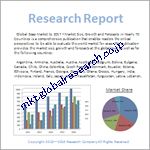目次
第1章.シミュレーションソフトウェアの世界市場 エグゼクティブサマリー
1.1.シミュレーションソフトウェアの世界市場規模・予測(2022年~2032年)
1.2.地域別概要
1.3.セグメント別概要
1.3.1.コンポーネント別
1.3.2.展開別
1.3.3.アプリケーション別
1.3.4.最終用途別
1.4.主要動向
1.5.景気後退の影響
1.6.アナリストの提言と結論
第2章.世界のシミュレーションソフトウェア市場の定義と調査前提
2.1.調査目的
2.2.市場の定義
2.3.調査の前提
2.3.1.包含と除外
2.3.2.限界
2.3.3.供給サイドの分析
2.3.3.1.入手可能性
2.3.3.2.インフラ
2.3.3.3.規制環境
2.3.3.4.市場競争
2.3.3.5.経済性(消費者の視点)
2.3.4.需要サイド分析
2.3.4.1.規制の枠組み
2.3.4.2.技術の進歩
2.3.4.3.環境への配慮
2.3.4.4.消費者の意識と受容
2.4.推定方法
2.5.調査対象年
2.6.通貨換算レート
第3章.シミュレーションソフトウェアの世界市場ダイナミクス
3.1.市場促進要因
3.1.1.自動車産業における需要の高まり
3.1.2.ヘルスケアアプリケーションの進歩
3.1.3.航空宇宙・防衛分野の成長
3.1.4.インダストリー4.0技術の統合
3.2.市場の課題
3.2.1.初期投資コストの高さ
3.2.2.複雑なレガシーシステムとの統合
3.2.3.データ・セキュリティへの懸念
3.3.市場機会
3.3.1.新興市場におけるシミュレーションソフトウェアの拡大
3.3.2.クラウドベースのソリューションの利用拡大
3.3.3.中小企業における採用の増加
第4章.シミュレーションソフトウェアの世界市場産業分析
4.1.ポーターの5フォースモデル
4.1.1.サプライヤーの交渉力
4.1.2.バイヤーの交渉力
4.1.3.新規参入者の脅威
4.1.4.代替品の脅威
4.1.5.競合他社との競争
4.1.6.ポーターの5フォースモデルへの未来的アプローチ
4.1.7.ポーター5フォースのインパクト分析
4.2.PESTEL分析
4.2.1.政治的
4.2.2.経済的
4.2.3.社会的
4.2.4.技術的
4.2.5.環境
4.2.6.法律
4.3.トップ投資機会
4.4.トップ勝ち組戦略
4.5.破壊的トレンド
4.6.業界専門家の視点
4.7.アナリストの推奨と結論
第5章.シミュレーションソフトウェアの世界市場 コンポーネント別規模・予測(2022年~2032年)
5.1.セグメントダッシュボード
5.2.シミュレーションソフトウェアの世界市場コンポーネント別売上動向分析、2022年および2032年 (百万米ドル/億ドル)
5.2.1.ソフトウェア
5.2.2.サービス
第6章.シミュレーションソフトウェアの世界市場規模・展開別予測(2022~2032年)
6.1.セグメントダッシュボード
6.2.シミュレーションソフトウェアの世界市場2022年および2032年の展開収益動向分析(百万米ドル/億ドル)
6.2.1.クラウドベース
6.2.2.オンプレミス
第7章.シミュレーションソフトウェアの世界市場規模・用途別予測(2022年~2032年)
7.1.セグメントダッシュボード
7.2.シミュレーションソフトウェアの世界市場アプリケーション収益動向分析、2022年および2032年 (百万米ドル/億ドル)
7.2.1.自動車
7.2.2.ヘルスケア
7.2.3.航空宇宙・デザイン
7.2.4.その他
第8章.シミュレーションソフトウェアの世界市場規模・用途別予測(2022年〜2032年)
8.1.セグメントダッシュボード
8.2.シミュレーションソフトウェアの世界市場エンドユースの収益動向分析、2022年および2032年 (百万米ドル/億ドル)
8.2.1.従来の自動車
8.2.2.ヘルスケア
8.2.3.航空宇宙・防衛
8.2.4.その他
第9章.シミュレーションソフトウェアの世界地域別市場規模・予測(2022〜2032年)
9.1.北米シミュレーションソフトウェア市場
9.1.1.米国シミュレーションソフトウェア市場
9.1.1.1.コンポーネント内訳の規模と予測、2022-2032年
9.1.1.2.展開の内訳規模と予測、2022年~2032年
9.1.2.カナダのシミュレーションソフトウェア市場
9.2.欧州シミュレーションソフトウェア市場
9.2.1.英国シミュレーションソフトウェア市場
9.2.2.ドイツのシミュレーションソフトウェア市場
9.2.3.フランスシミュレーションソフトウェア市場
9.2.4.イタリアのシミュレーションソフトウェア市場
9.2.5.その他のヨーロッパのシミュレーションソフトウェア市場
9.3.アジア太平洋シミュレーションソフトウェア市場
9.3.1.中国シミュレーションソフトウェア市場
9.3.2.インドのシミュレーションソフトウェア市場
9.3.3.日本のシミュレーションソフトウェア市場
9.3.4.韓国シミュレーションソフトウェア市場
9.3.5.その他のアジア太平洋地域のシミュレーションソフトウェア市場
9.4.中南米シミュレーションソフトウェア市場
9.4.1.ブラジルシミュレーションソフトウェア市場
9.4.2.メキシコのシミュレーションソフトウェア市場
9.4.3.その他のラテンアメリカのシミュレーションソフトウェア市場
9.5.中東・アフリカのシミュレーションソフトウェア市場
9.5.1.サウジアラビアのシミュレーションソフトウェア市場
9.5.2.南アフリカのシミュレーションソフトウェア市場
9.5.3.その他の中東・アフリカ地域のシミュレーションソフトウェア市場
第10章 シミュレーションソフトウェア市場競合他社の動向
10.1.主要企業のSWOT分析
10.1.1.ANSYS, Inc.
10.1.2.シーメンス・デジタル・インダストリーズ・ソフトウェア
10.1.3.ダッソー・システムズ
10.2.トップ市場戦略
10.3.企業プロフィール
10.3.1.ANSYS, Inc.
10.3.1.1.主要情報
10.3.1.2.概要
10.3.1.3.財務(データの入手可能性による)
10.3.1.4.製品概要
10.3.1.5.市場戦略
10.3.2.シーメンス・デジタル・インダストリーズ・ソフトウェア
10.3.3.ダッソー・システムズ
10.3.4.アルテアエンジニアリング
10.3.5.オートデスク
10.3.6.PTC Inc.
10.3.7.コムソル
10.3.8.MathWorks, Inc.
10.3.9.AVEVA Group plc
10.3.10.MSC Software Corporation
第11章.研究プロセス
11.1.研究プロセス
11.1.1.データマイニング
11.1.2.分析
11.1.3.市場推定
11.1.4.バリデーション
11.1.5.出版
11.2.研究属性
________________________________________
表一覧
表 1.シミュレーションソフトウェアの世界市場、レポート範囲
表2.シミュレーションソフトウェアの世界市場2022-2032年地域別推計・予測(百万米ドル/億ドル)
表3.シミュレーションソフトウェアの世界市場予測:コンポーネント別 2022-2032年 (百万米ドル/億米ドル)
表4.シミュレーションソフトウェアの世界市場展開別推計&予測 2022-2032年 (百万米ドル/億ドル)
表5.シミュレーションソフトウェアの世界市場セグメント別推計・予測 2022-2032 (百万米ドル/億ドル)
表6.シミュレーションソフトウェアの世界市場、地域別予測、2022-2032年 (百万米ドル/億ドル)
表7.シミュレーションソフトウェアの世界市場、セグメント別予測、2022-2032年 (百万米ドル/億ドル)
表8.シミュレーションソフトウェアの世界市場、地域別、推計・予測、2022-2032年 (百万米ドル/億ドル)
表9.シミュレーションソフトウェアの世界市場、セグメント別予測、2022-2032年 (百万米ドル/億ドル)
表10.シミュレーションソフトウェアの世界市場、地域別、推計・予測、2022-2032年 (百万米ドル/億ドル)
表11.シミュレーションソフトウェアの世界市場、セグメント別予測、2022-2032年 (百万米ドル/億ドル)
表12.シミュレーションソフトウェアの世界市場、地域別、推計・予測、2022-2032年 (百万米ドル/億ドル)
表 13.シミュレーションソフトウェアの世界市場、セグメント別予測、2022-2032年 (百万米ドル/億ドル)
表14.シミュレーションソフトウェアの世界市場、地域別、推計・予測、2022-2032年 (百万米ドル/億ドル)
表15.米国シミュレーションソフトウェア市場予測、2022-2032年 (百万米ドル/億ドル)
表16.米国のシミュレーションソフトウェア市場セグメント別推計および予測、2022-2032年 (百万米ドル/億ドル)
表17.米国のシミュレーションソフトウェア市場セグメント別推計&予測 2022-2032 (百万米ドル/億ドル)
表18.カナダ シミュレーションソフトウェア市場 2022-2032年予測 (百万米ドル/億ドル)
表 19.カナダシミュレーションソフトウェア市場セグメント別推計&予測 2022-2032 (百万米ドル/億ドル)
表 20.カナダのシミュレーションソフトウェア市場セグメント別推計&予測(2022-2032年) (百万米ドル/億ドル)
…..
このリストは完全なものではなく、最終報告書には100以上の表が含まれています。リストは最終成果物で更新される可能性があります。
図1.シミュレーションソフトウェアの世界市場、調査方法
図2. シミュレーションソフトウェアの世界市場、市場予測手法
図3. 世界の市場規模予測・予測手法
図4.シミュレーションソフトウェアの世界市場、主要動向2023年
図5.シミュレーションソフトウェアの世界市場、成長見通し2022年~2032年
図6. シミュレーションソフトウェアの世界市場、ポーターズ5フォースモデル
図7. シミュレーションソフトウェアの世界市場、PESTEL分析
図8. シミュレーションソフトウェアの世界市場、バリューチェーン分析
図9. シミュレーションソフトウェアの世界市場(セグメント別)、2022年および2032年(百万ドル/億ドル
図10.シミュレーションソフトウェアの世界市場、セグメント別、2022年&2032年(百万ドル/億ドル)
図11.シミュレーションソフトウェアの世界市場、セグメント別、2022年&2032年(百万米ドル/億米ドル)
図12.シミュレーションソフトウェアの世界市場、セグメント別、2022年&2032年(百万米ドル/億米ドル)
図13.シミュレーションソフトウェアの世界市場、セグメント別、2022年&2032年(百万米ドル/億米ドル)
図14.シミュレーションソフトウェアの世界市場、地域別スナップショット(2022年&2032年
図15.北米シミュレーションソフトウェア市場 2022年~2032年 (百万米ドル/億米ドル)
図16.欧州シミュレーションソフトウェア市場 2022 & 2032 (百万米ドル/億米ドル)
図17.アジア太平洋シミュレーションソフトウェア市場 2022 & 2032 (百万米ドル/億米ドル)
図18.中南米シミュレーションソフトウェア市場 2022 & 2032 (百万米ドル/億米ドル)
図 19.中東・アフリカ シミュレーションソフトウェア市場 2022~2032 (百万米ドル/億米ドル)
図 20.シミュレーションソフトウェアの世界市場、企業シェア分析(2023年)
…..
このリストは完全なものではなく、最終レポートには50以上の図表が含まれています。リストは最終成果物で更新される可能性があります。
The global simulation software market is poised for extraordinary growth, anticipated to increase from USD 20.96 billion in 2023 to USD 67.09 billion by 2032, reflecting a compound annual growth rate (CAGR) of 13.80% over the forecast period from 2024 to 2032. Simulation software plays an indispensable role in various industries by allowing for the accurate modeling of complex systems and processes. From automotive design to healthcare and aerospace engineering, the ability to simulate and predict real-world behaviors and outcomes enables organizations to optimize products and services before deployment. Simulation tools have become critical in industries where precision and cost-efficiency are paramount, offering enhanced flexibility, improved risk management, and significant reductions in operational costs.The global market is being fueled by growing demand across key sectors, particularly in automotive, healthcare, aerospace, and industrial design. In the automotive industry, for example, simulation software aids in designing more efficient, safer vehicles, optimizing everything from engine performance to crash testing. Likewise, the healthcare industry benefits greatly from simulation software for modeling drug interactions, surgical procedures, and personalized medicine strategies. Aerospace and defense manufacturers are leveraging simulation tools for flight testing, design verification, and structural analysis. The advent of Industry 4.0, which integrates advanced digital technologies into manufacturing, is also significantly propelling the use of simulation software across these industries.
Moreover, the versatility of simulation tools in a variety of environments—whether cloud-based or on-premises—continues to push market expansion. With cloud-based deployment rapidly gaining traction, companies are no longer confined to large in-house systems and can scale their simulation operations dynamically. Service providers are increasingly offering simulation software as a service (SaaS), making it more accessible for small and medium-sized enterprises (SMEs) to implement these tools without hefty upfront investments. This is expected to drive growth in new and emerging markets, particularly in the Asia-Pacific region, where demand for simulation software is forecast to see some of the fastest growth rates.
In terms of regional growth, North America currently holds the largest share of the simulation software market, driven by substantial investments from major players like Ansys, Siemens Digital Industries Software, and Dassault Systèmes. However, Asia-Pacific is poised to emerge as the fastest-growing region during the forecast period, spurred by rapid industrialization, increased demand from automotive manufacturers in countries like China and Japan, and expanding aerospace and healthcare sectors. Europe, too, is experiencing robust growth due to the rising adoption of simulation software across aerospace, automotive, and manufacturing industries.
Major market players included in this report are:
• ANSYS, Inc.
• Siemens Digital Industries Software
• Dassault Systèmes
• Altair Engineering Inc.
• Autodesk, Inc.
• PTC Inc.
• COMSOL Inc.
• MathWorks, Inc.
• AVEVA Group plc
• MSC Software Corporation
• Trimble Inc.
• Honeywell International Inc.
• Emerson Electric Co.
• Rockwell Automation, Inc.
• SAP SE
The detailed segments and sub-segment of the market are explained below:
By Component:
• Software
• Service
By Deployment:
• Cloud-based
• On-premises
By Application:
• Automotive
• Healthcare
• Aerospace & Design
• Others
By End Use:
• Conventional Automotive
• Healthcare
• Aerospace & Defense
• Others
By Region:
North America
• U.S.
• Canada
Europe
• UK
• Germany
• France
• Italy
• Rest of Europe
Asia Pacific
• China
• India
• Japan
• South Korea
• Rest of APAC
Latin America
• Brazil
• Mexico
Middle East & Africa
• Saudi Arabia
• South Africa
• Rest of MEA
Years considered for the study are as follows:
• Historical year – 2022
• Base year – 2023
• Forecast period – 2024 to 2032
Key Takeaways:
• Market Estimates & Forecast for 10 years from 2022 to 2032
• Annualized revenues and regional level analysis for each market segment
• Detailed analysis of geographical landscape with Country level analysis of major regions
• Competitive landscape with information on major players in the market
• Analysis of key business strategies and recommendations on future market approach
• Analysis of competitive structure of the market
• Demand side and supply side analysis of the market
❖ 免責事項 ❖
http://www.globalresearch.jp/disclaimer

